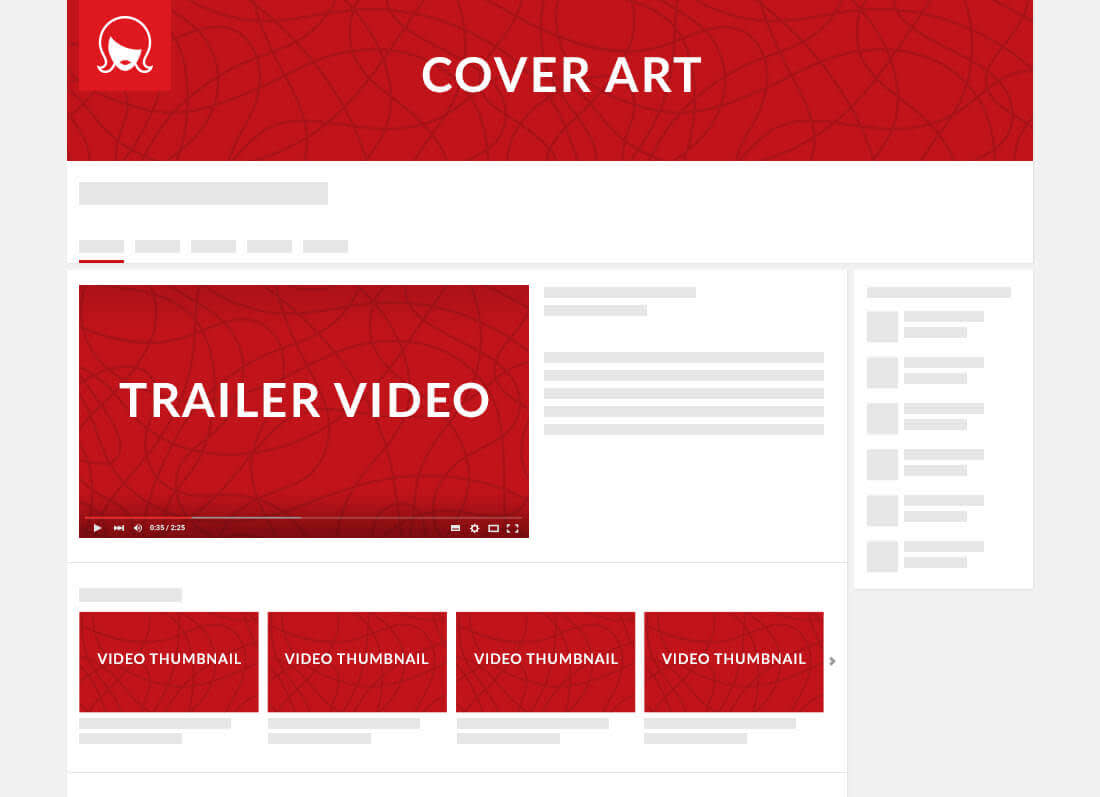Video. It’s the word that’s on the tip of every social media marketer’s tongue. It gets people hooked and watching for hours at a time. And it’s the key ingredient in the most popular social networks on the planet. Video is where it’s at, and the sooner businesses embrace that concept, the sooner they’ll be able to reap the rewards of this most dynamic medium.
Most social channels are incorporating video into their platforms, but YouTube remains the king of video. Not only that, YouTube now ranks as the second largest search engine (behind Google) and the second most popular social site (right after Facebook), with 1 billion unique visitors and 3 billion searches each month.
Despite these impressive stats, businesses big and small often shy away from YouTube, believing that making a play in the world of video is beyond their reach. They’re put off by the greater costs, time, and expertise that video requires and are hesitant to jump into an unfamiliar arena. But the truth is, with a little work and minimal investment, anyone can create a YouTube channel that draws viewers and showcases their brand.
Cover art

Once you set up your YouTube channel, you can upload a custom banner or cover. PicMonkey can help you design your own image from scratch using our blank canvas sized at 2560 x 1440 pixels, or you can customize one of our professionally designed YouTube cover templates.
This image should be in keeping with your overall branding on social media, but feel free to make something that’s specifically for your YouTube channel. Keep in mind that you’ll be adding an icon—usually your logo or profile pic—to the upper left-hand corner, and links to your website or other social platforms will be placed in the bottom right-hand corner, so don’t put any important visual elements in those spots. For the mobile version of your cover, the logo will be on the bottom left and there won’t be any social icons.
You’ll notice the proportions of this image are very different from the banner you see at the top of your channel on your computer. That’s because YouTube asks you to upload a single image for all three of its display options—desktop, phone, and TV—and then has you crop that one image for the different displays. Fortunately, we’ve designed our templates so they can be used in all three forms, as you can see here:

Videos
Before going much further in creating your channel, it would probably be a good idea to get one or two videos under your belt. What you choose to include on your channel will depend on what your business, interests, and goals are, but here are some things to keep in mind as you begin the video-making process.
Content – YouTube users are generally looking for one of two things: entertainment or education. That means the most high-performing videos fall into one, or preferably both, of these categories. An entertaining video might make you laugh, cry, or think. It could beguile you with gorgeous scenery or mesmerize you with a crazy scientific experiment. Sometimes they offer a behind-the-scenes look at a company’s offices or manufacturing plants.
Educational videos, on the other hand, focus on imparting knowledge of some kind. They include how-to’s, tutorials, product demos, advice, and explanations. You could also consider asking one of your customers to do a testimonial about your product or service.
While videos that are directly related to your business are great, don’t feel like you can’t go off on a tangent. Feel free to be fun and amusing and tackle subjects that your target audience is interested in. The most important thing is that you be yourself and let your personality shine through. Being on YouTube is a way to connect to your audience in an authentic way, by telling a story about yourself and your business and humanizing your brand.
Equipment – Even the most popular, respected YouTube creators will tell you that fancy, expensive equipment is not necessary for video creation. Many use the cameras on their phones or tablets or they invest in a similarly easy-to-use, relatively cheap camera. While some creators choose to use the microphone that’s built into their device, others purchase microphones to plug in for about $50 or so.
Background and lighting – Many creators choose to maintain a consistent background for all of their videos. This helps make them appear more unified and on brand. It’s common to see a plain white background, either created by using a backdrop or by shooting against a white wall. Others like to show their home or office in the background. Additional lighting, beyond what you already have in your shooting space, is a great way to increase the quality of your video. You could invest in a lighting kit for as little as $50, or you could go to a home improvement store and buy some cheap metal clamp lights.
Length – Getting the length right is critical in the world of video. Some YouTube creators swear by the maxim that not even a second of boredom should creep into your video. They edit heavily, speed up the slow parts, and cut out anything extraneous. And yet, there are many popular creators who seem to embrace the mundane. While some people might find watching 19 minutes of someone applying make-up mind-numbing, others find it enthralling. Be sure not to edit down so much that you lose critical information. People are willing to watch a whole video if they learn something beneficial. Also remember that it’s important to get your viewers to watch as much of your video as possible, because the longer they watch, the more valuable your video will be deemed by YouTube and your rankings will go up. It’s best to give the most pertinent information as quickly as possible, so your viewers don’t have to wait around for the meat of your video.
Editing – Lots of people opt to use free editing software, often whatever is included on their laptop, such as iMovie, Windows Movie Maker, or LightWorks. Others prefer using more advanced software, such as Final Cut Pro, Camtasia, and Pinnacle. Whatever you choose, be sure you use it wisely. Don’t go too heavy on the special effects or your video might come off as unprofessional, but do take advantage of available features that help you make your video look polished. Lots of video makers will put in some background music to add variety and interest, even if there’s talking in the video. Make sure it isn’t so loud as to drown out the voices or too soft that you can’t hear it.
Subtitles – Not only do subtitles make your video accessible to the hearing impaired, but including subtitles also allows people to watch your video when they’re in a public place. There’s actually a sizable group of people who won’t watch a video unless it has subtitles. You can add them with YouTube’s automatic closed caption feature, or you can create your own in the editing process.
Trailer video
Each YouTube channel has a spot up top for a single video that’s bigger and more prominent than the rest. Some people see this as the place to put their best or most recent video. However, it’s actually known as a “trailer video” and is intended to serve as a way to introduce people to your channel and get them to subscribe.
YouTube experts recommend that this video be no longer than a minute or two and provide a personalized welcome to nonsubscribers. Basically, you want to convince people that they’ve come to the right place for great, informative, entertaining content. Studies show that channels get many more subscribers from this trailer video than from regular videos, so be sure to emphasize your call to action to subscribe. You can do that verbally by telling people how to subscribe, and visually by including an end screen with a subscribe button. YouTube offers a way to add an end screen to your video. These screens should be included at the end of all of your videos, both to increase subscribers and to get people to watch another one of your videos.
Thumbnails

You can make an absolutely fabulous video, but if you can’t get anyone to click on it, no one will see it. To avoid that terrible fate, you’ll need to design an eye-catching thumbnail. Once again, PicMonkey’s got you covered, with easy-to-use design and editing tools and customizable templates.
Thumbnails need to stand out from the crowd with striking graphics, but they also need to convey what people will get if they click on it. Most people don’t want to waste their clicks, so it’s a good idea to include a brief title that describes what the video is all about. The most successful YouTube creators tend to have thumbnails with a consistent, unified look in order to solidify their brand, so consider using a single template for all of your thumbnails.
Tips:
Don’t put any important information or design elements in the bottom right-hand corner of your thumbnail, because that’s where the YouTube timestamp is located.
Since many people watch YouTube videos on their phone, consider how your thumbnail is going to look on the small screen. Try using PicMonkey’s Sharpen tool to ratchet up the sharpness of your image, and the Colors tool to increase the saturation and make your colors bolder and brighter.

Search optimization
Getting your videos seen on YouTube requires special attention to search optimization. The first thing to attend to are your keywords. Do a search on possible keywords in Google and YouTube and find out which ones are most popular. You can use Google’s Keyword Planner to help. Once you’ve identified those, you’ll want to include them in your video’s title, description, and tags. You’ll be able to set your tags when you upload your video to YouTube. If you’re adding captions or subtitles, that’s another way to get your keywords found by search engines.
Promotion
One of the best ways to promote your YouTube channel is to form partnerships with other YouTube creators and websites that have similar interests as you. For example, if you’re a landscape artist, you could look for YouTube channels, websites, and blogs belonging to local nurseries, plant experts, and gardening enthusiasts. By forming positive, constructive relationships with these individuals and businesses, you’ll be able to share followers, cross promote, and build engagement. And don’t forget to promote your videos on your other social media networks and your website, blog, or online store.
Engagement
YouTube is an inherently personal social networking platform. If you’re the star of your videos, you’re putting yourself out there in a powerful way that’s both thrilling and a little scary. For the most part, YouTube users are a welcoming bunch and eager to connect with YouTube creators they like. Be sure to embrace your subscribers by responding to their comments and soliciting their opinions. The more you can engage on a personal level, the more likely it is that people will want to continue watching your videos and hopefully buy your products or services. Of course, there are also plenty of haters and trolls out there who will post mean comments just to get a reaction from you. Feel free to ignore such negativity or respond with a heavy dose of positivity. You might find that you don’t even have to respond because your fans will do it for you!
